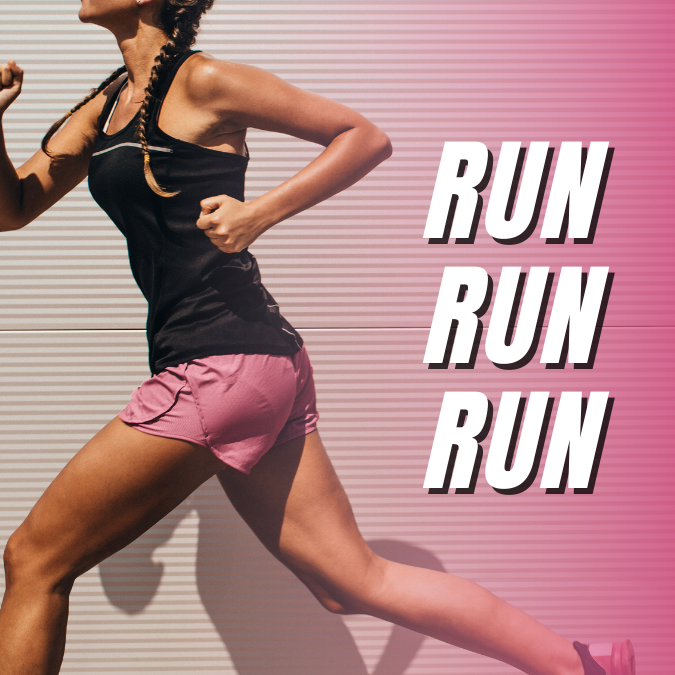
Strength training can be extremely beneficial to runners. For starters, stronger leg muscles can provide more power when running, while stronger connective tissues (tendons and ligaments) can reduce injury risk. Improving your upper-body strength can also help you run faster. With a stronger core, you’ll be able to keep your upper body stable, reducing side-to-side movement – and hold your form better at the end of a race when you start to tyre. And by strengthening your arms, you’ll improve your arm drive, allowing you to inject more power into your stride. The following workout focuses on the legs, arms, and core.
The following workout focuses on the legs, arms, and core. Begin by performing the exercises with only your own bodyweight and gradually progress to using free weights as you feel stronger.
How to Carry Out These Exercises:
Follow the exercises in the order listed below, resting 90 seconds between sets and two minutes before moving on to the next. Concentrate on perfecting your form rather than completing the exercises as quickly as possible when following this routine. Use a mirror or a friend to double-check that you’re doing the exercises correctly.
Press-ups
Benefits: Improves posture and arm drive while running by strengthening the chest, shoulders, and arms.
Lay face down on the floor, with your hands on either side of your chest. Your toes should be tucked beneath your feet.
Raise your body off the floor by pressing down into your hands. Maintain a straight posture and avoid stretching your neck.
Lower your body back down, almost to the floor, and repeat when your arms are nearly fully extended (don’t lock your elbows).
Dumbbell row
Benefits: Strengthens the upper back to balance out the strength of the chest.
Place your left hand and knee on a bench. Your upper body should be parallel to the ground.
Take a dumbbell in your right hand and hold it with your arm extended towards the floor.
Pull the weight towards you, keeping your elbow close to your waist, and then return to the starting position.
Tricep dips
Benefits: Strengthens the arms and shoulders, allowing you to maintain an upright running posture.
Sit with your heels on the edge of a bench and your fingers over the edge.
Lift your arms off your body and lower yourself down while bending at the elbows. Repeat by pushing back up with your arms (avoid using your legs to lift yourself).
Step-ups
Benefits: Improves running power by working all major muscle groups in the legs.
Sit with your heels on the edge of a bench and your fingers over the edge.
Lift your arms off your body and lower yourself down while bending at the elbows. Repeat by pushing back up with your arms (avoid using your legs to lift yourself).
Step-ups
Benefits: Improves running power by working all major muscle groups in the legs.
Stand in front of a bench or box that is strong enough to support your weight.
Place one foot on the bench and push off your back leg to step up, keeping your body tall and your knee on your supporting leg over your ankle.
Consider bringing your hips forward and up instead of pulling forward with your knees.Raise your trail leg to a high knee position without letting it touch the bench. Then lower it to the floor again.
Hold dumbbells in each hand to increase the difficulty.
Squats
Benefits: Strengthens the major muscle groups used in running, lowering the risk of injury. Additionally, it increases flexibility for a faster, more efficient running stride.
Stand with your feet
wider than hip-width apart and your toes pointing slightly outwards.
Lower yourself down, bending at the knees and hips as if you were sitting in a chair.
Maintain a straight line with your knees over your ankles and your chest up. Concentrate on your bum going back.
Lower yourself almost to a sitting position, then push up through your heels to regain your standing position.
Hold a kettlebell at chest height to increase the difficulty.
Walking lunges
Benefits: Improves single-leg balance for better running stability and coordination. It also lengthens your stride, allowing you to run faster.
Place your feet shoulder-width apart.
Take a large step forward with one leg and lower your body and back knee to the floor, making sure not to make contact.
Maintain an upright posture by keeping your front knee over your ankle.
Push off with your back leg and step your front leg back to meet your back leg.
Rep, alternating your leading leg.
Single-leg deadlift
Benefits: Increases running power by strengthening the glutes and hamstrings while also improving stability for a lower risk of injury.
Stand tall with a dumbbell or kettlebell in your right hand.
Extend your left leg behind you and lift your left foot off the floor. Bend forward at the hips while keeping your back straight and your right arm extended toward the floor.
Maintain a slight bend in your right knee and level hips.
Return to the starting position and repeat on the other side, bringing the weight almost to the floor and your back as close to horizontal as possible.